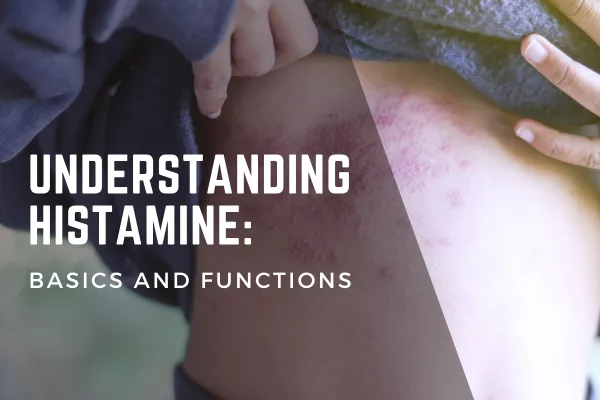
Understanding Histamine: Basics and Functions
Histamine is a chemical that plays a crucial role in the body's immune response. It helps to regulate inflammation and promotes healing. However, too much of it in the body can lead to a range of symptoms, including allergies, skin conditions, digestive problems, and more. In this blog post, we will explore the basics of it and its function in the body. We will also discuss how elevated levels can manifest in different situations and how to recognize them. Additionally, we will provide practical tips to reduce the levels in your body and answer frequently asked questions about it. Whether you are dealing with histamine intolerance or just want to learn more about this important compound, this post is for you!
If you run a website, chances are you already have a blog. And if you don’t, maybe you should start one. A blog can boost your brand awareness, increase conversions, and improve customer service.
Blogs help you connect with your audience on a more personal level and allow them to interact with you in an individual capacity. Blogging also helps to present viewers with fresh content regularly.
Define Histamine: A Simple Explanation
The technical definition is a compound which is released by cells in response to injury and in allergic and inflammatory reactions, causing contraction of smooth muscle and dilation of capillaries. Basically, it is a vital chemical in bodily functions, plays an important role in allergic reactions, gastric acid secretion, and immune response regulation.
Histamine, often the unsung hero in our body's defense, assumes a pivotal role akin to our body's smart home security system. Visualize mast cells as specialized guardians strategically stationed throughout, especially in areas prone to potential encounters with invaders. These mast cells act as the frontline security personnel. When an intruder, be it an allergen or pathogen, is detected, mast cells swiftly respond by ringing the alarm – releasing histamine.
Therefore, it serves as the alert signal that sets the immune system into motion, prompting a rapid response. Think of mast cells as the agile responders rushing to the scene, coordinating a robust defense. Simultaneously, it's effects, including increased blood flow and enhanced vessel permeability, play a crucial role in fortifying the body's defenses and ensuring the swift movement of vital resources. This orchestrated defense mechanism mirrors the intricate workings of a smart home security system, ensuring a rapid and effective response to potential threats.

Histamine What is it and Why it Matters
Histamine, a hydrophilic vasoactive amine, is a biogenic amine produced from the amino acid histidine. It plays an important role in allergic conditions and allergic inflammation, involving effects on blood vessels, stomach acid, and smooth muscle cells. This chemical is a key mediator of watery eyes and is also crucial in allergic asthma, with clinical efficacy in the treatment of neurodegenerative diseases. Understanding it's effects is vital, as it influences bodily functions and has a significant impact on the immune system, making it essential to recognize its types of receptors and receptor antagonists.
The Use of Histamine in Body Processes
The body synthesizes histamine via histidine decarboxylase in mast cells, contributing to allergic responses. Mast cell activation syndrome prompts its release during allergic conditions. It regulates immune reactions, gastric acid secretion, and smooth muscle activity. It interacts with a diverse range of receptors, including those on endothelial cells and white blood cells, impacting various bodily functions.
Real-Life Examples of the Effects of Histamine
Histamine has a crucial role in the inflammatory response, allergy symptoms, and body temperature regulation. It is involved in allergic rhinitis, atopic dermatitis, and allergic inflammation, leading to nasal congestion, runny nose, and inflammatory disorders. Understanding the stimulation of gastric acid secretion is key to having a balanced view of it's value to your body. Additionally, it plays a vital role in bone marrow, dendritic cells, and allergic conjunctivitis, influencing various bodily functions and immune system responses.

How It is Connected to Allergies and Skin Conditions
Histamine release during allergic reactions leads to allergy symptoms and conditions, crucial in atopic dermatitis, allergic rhinitis, and nasal congestion. Understanding its effects on body temperature, allergic asthma, and mast cell activation is important. High levels are involved in allergic conjunctivitis, watery eyes, and activation of smooth muscle cells, playing a key role in the body's immune response, T cells, B cells, and white blood cells, also known as Mast Cells. These interactions highlight the critical role of this chemical in allergic responses and skin conditions.
The Connection to Digestive Problems
Histamine levels significantly influence gastric acid secretion and stomach acid regulation, impacting immune cells, mast cells, and blood vessels, especially in celiac disease. In allergic conditions, chemical histamine release is a key factor in gastric acid secretion and immune cell response, playing a central role in smooth muscle cell activation, vascular functions, and blood pressure regulation. Understanding histamine's effects on inflammatory disorders and allergic conditions is crucial for maintaining healthy bodily functions and managing clinical efficacy.
If you want to check to see if there is a hidden infection connected to your digestive issues, then I highly recommend using Sun Genomics at-home gut test. Any information reveled will help you focus efforts on the right stressor weighing your body down. Use the code STRESSOLOGY for $25 off your order.

Histamine does what to Influence Sleep and Wakefulness
Histamine, crucial for bodily functions, impacts cognitive function and inflammatory response. It regulates gastric acid secretion and plays a role in allergic conditions. Additionally, histamine is involved in body temperature regulation, blood cell function, and mast cell activation syndrome. Its effects on nasal congestion, immune response, and blood vessels are also important, along with its involvement in smooth muscle cell activation, heart rate regulation, and pressure control. Recognizing it's influence on sleep and wakefulness is vital for understanding its clinical efficacy in managing sleep-related disorders.
In Traditional Chinese Medicine (TCM), the liver is considered most active during the "Liver Qi Time," typically between 1:00 AM and 3:00 AM, focusing on detoxification and rejuvenation. While not exclusively tied to histamine, the liver's nighttime activity aligns with Western medicine's understanding of the body's natural detox processes. Excess levels, accumulated throughout the day due to immune or stress responses, may contribute to disruptions in this nocturnal detoxification, potentially leading to waking up during the night. Bridging these perspectives emphasizes the importance of balancing histamine levels and supporting the liver's functions for overall well-being.
Recognizing Histamine Intolerance: Signs and Symptoms
High levels can lead to a range of health issues, including multiple sclerosis, allergic rhinitis, and allergic inflammation. Recognizing symptoms of histamine intolerance is crucial, as it can provide important clues to mitigate symptoms through diet and lifestyle changes. Additionally, high levels may indicate a condition called mast cell activation as mast cells release and produce histamine as part of an immune or stress response. Additionally, high levels are connected to allergic asthma, and allergic conjunctivitis.
Common Symptoms of Elevated Histamine
Elevated histamine levels may manifest as allergic conditions, atopic dermatitis, and nasal congestion. Recognizing histamine intolerance symptoms is crucial in allergic rhinitis and allergic inflammation. It can induce allergic conjunctivitis, watery eyes, and activate smooth muscle cells in the body. Chronically elevated levels can lead to mast cell activation syndrome, allergic asthma, IBS, and increased gastric acid secretion. Understanding it's effects on immune cells, heart rate, and blood pressure is essential for recognizing and addressing elevated histamine system symptoms.

How Histamine Can Trigger Certain Conditions
The body's response to histamine can trigger a variety of conditions, playing a central role in allergic conditions, allergic rhinitis, and nasal congestion. Understanding its effects on immune cells, smooth muscle cells, and body temperature is also important, as high levels are correlated to mast cell activation syndrome, allergic asthma, and allergic conjunctivitis. Furthermore, recognizing it's effects in gastric acid secretion, allergic rhinitis, and watery eyes is essential in understanding its clinical efficacy.
Everyday Triggers of Histamine Release
Everyday triggers of histamine release include mast cell activation, which occurs in response to allergic reactions. When the immune system identifies allergens, it activates mast cells, leading to its release . These histamine receptor antagonists play an important role in various bodily functions, affecting vascular smooth muscle cells and contributing to allergic conditions. Understanding these triggers is crucial for managing clinical efficacy and addressing symptoms associated with elevated levels.
Foods that Can Increase your Levels
When individuals experience symptoms associated with excess histamine, such as allergy-like manifestations, dietary considerations often become a primary focus, serving as a key indicator for uncovering related issues. However, navigating a low-histamine diet can be challenging, as a multitude of foods contain varying levels of it or may trigger its release in the body. Recognized as primary culprits, certain foods like aged cheeses, fermented items, processed meats, and alcoholic beverages are commonly associated with excessive levels. Managing your intake becomes a nuanced task, necessitating an understanding of both highly ranked foods and those that prompt the body to release it as well. As individuals embark on this dietary exploration, they find that balancing nutritional needs with a sensitivity is pivotal for alleviating symptoms and promoting overall wellness. That being said, I highly recommend watching this video:
Other Factors that Can Trigger Its Release
Mast Cells that carry and release it also play a crucial role in the stress response. While most people think of stress as only a mental health issue, it is actually the body's process for identifying and responding to any demand for change. Our perspective of those changes is crucial to decreasing our likelihood of an extreme stress response. Additionally, environmental elements like pollen have the potential to initiate its release, particularly in individuals with allergies. These factors play an important role in triggering the release and can have significant clinical efficacy in understanding allergic reactions. That is why simply focusing on diet and supplements alone isn't enough as if you are stuck in a stress loop your body is going to keep creating it faster than you can process it.
Dealing with Histamine Intolerance
Understanding and recognizing histamine intolerance symptoms is crucial for diagnosis and treatment. By making conscious consumption choices, you can bring your body back to a neutral-ish place to identify other triggers and determine the best ways to support your body in naturally detoxing from the high levels the chemical and any toxins or stressors in your body. If you're unsure of what exactly is adding to your overall load trigger a stress response, you might want to consider buying the Root Cause Roadmap which outline the 12 stress categories along with further reading and resources to support your personal investigation.

When Should You Seek Medical Help?
If you experience ongoing histamine intolerance symptoms or if they worsen over time, it is important to seek medical advice. Consulting a healthcare professional can help identify the underlying cause of your symptoms and provide appropriate treatment options. Through research and years of participation in online support groups, it is clear that those who have success typically work with holistic health, naturopathic, or functional medicine practitioners.
Frequently Asked Questions
Drinking plenty of water may help to regulate your levels in the body by aiding the kidneys in flushing out excess histamine. However, it's important to note that water alone may not be sufficient to entirely eliminate it from the system. Additionally, seasonal changes can indeed affect the levels in the body due to various environmental factors triggering its release and the subsequent immune response.
Can Drinking Water Flush It Out?
Drinking water alone cannot flush it out of the body. While hydration is important, it does not directly impact your levels. It's best to focus on other strategies to decrease consumption and increase your body's natural ability to detox it.
Is It Possible to Live a Normal Life with Histamine Intolerance?
That is like asking is it possible to live a normal life while in extreme stress. The answer is you have two choices. One, you can work to suppress symptoms and ignore signs that your load is too heavy for your body. Two, you can choose to do the proactive work to uncover why your body has high levels and do the work to mitigate those stressors. By decreasing your Total Stressor Load, you'll allow your body to function more optimally with time. I know this because this is the same process I've used for my own daughter and clients to heal from MCAS and a number of other related conditions. The choice is yours if you want to view this as a life sentence or a sign you have some work to do.
If you want to get started doing the work but aren't sure where to begin, I highly recommend the program below that I've created to give you everything you need to get started.

Conclusion
In conclusion, understanding the basics of histamine and its function is crucial for maintaining overall health and well-being. It plays a significant role in allergies, skin conditions, digestive problems, and sleep regulation. It is important to recognize the signs and symptoms of elevated levels and identify everyday triggers that can lead to its release. For individuals with histamine intolerance, implementing simple lifestyle changes and reducing the total stressor load on the body can significantly improve their quality of life. However, if symptoms persist or worsen, it is advisable to seek medical help. Remember, knowledge is power, and being aware of its value and its effects on the body empowers you to make informed decisions about your health.




